Strategic HRM Analysis: Performance and Reward at Samsung (HRM Report)
VerifiedAdded on 2020/05/28
|13
|2991
|82
Report
AI Summary
This report provides an in-depth analysis of Samsung's human resource management (HRM) practices, specifically focusing on its reward management system and its alignment with employee performance. The report begins by examining a case study highlighting Samsung's rewarding of its mobile division despite poor sales performance, which leads to an identification of the core problem: a lack of employee and management cooperation in designing the reward system. The report then details Samsung's reward management program, including its structure of yearly salaries, incentives, and non-financial rewards. The impact of bonuses on employee work performance is also analyzed, including the advantages of motivation and appreciation, and disadvantages such as increased costs and fairness issues. The report concludes by discussing strategic HRM approaches to align performance and rewards, referencing examples like the Kenya Power and Lighting Company (KPLC) and Continental Airlines, and offering recommendations for Samsung's HRM practices.
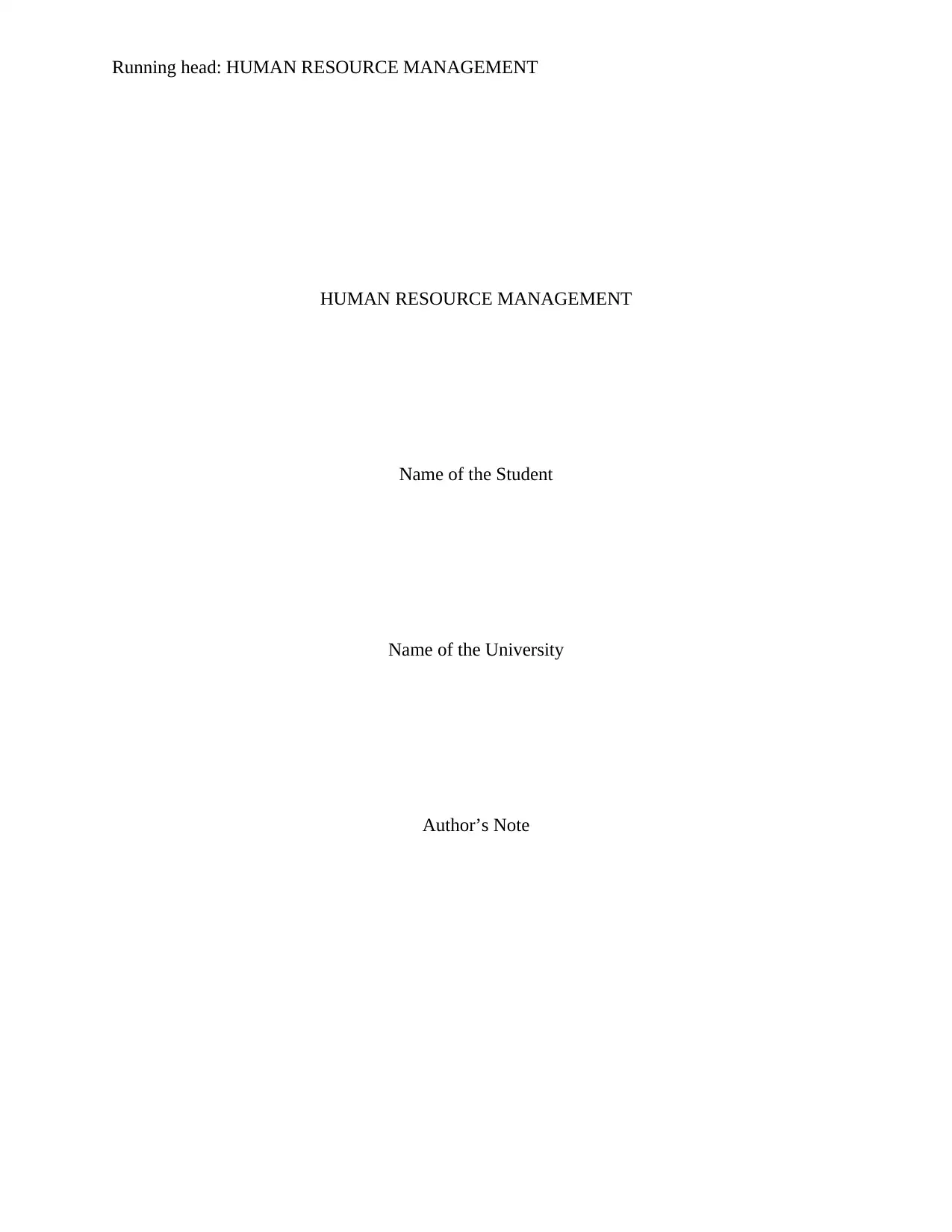
Running head: HUMAN RESOURCE MANAGEMENT
HUMAN RESOURCE MANAGEMENT
Name of the Student
Name of the University
Author’s Note
HUMAN RESOURCE MANAGEMENT
Name of the Student
Name of the University
Author’s Note
Paraphrase This Document
Need a fresh take? Get an instant paraphrase of this document with our AI Paraphraser
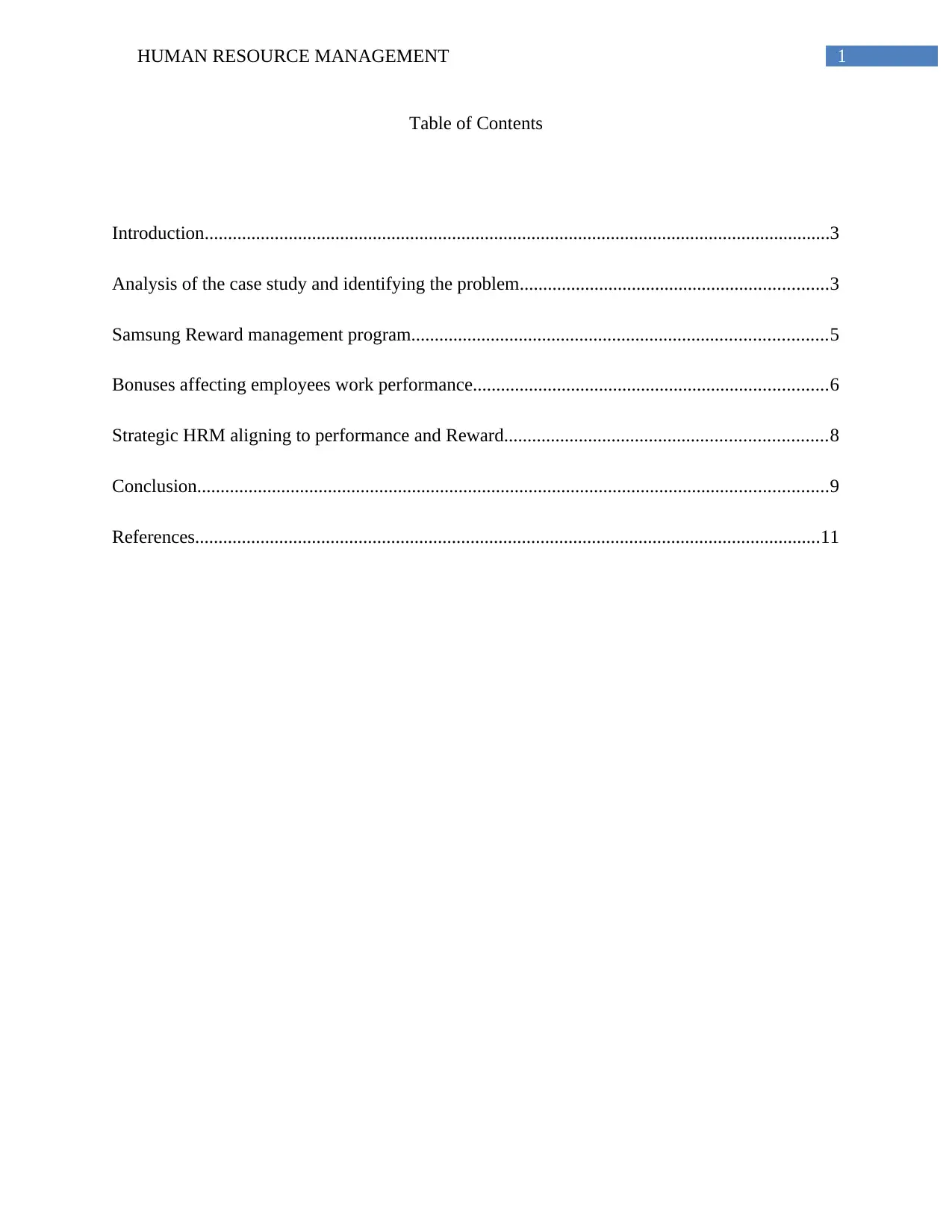
1HUMAN RESOURCE MANAGEMENT
Table of Contents
Introduction......................................................................................................................................3
Analysis of the case study and identifying the problem..................................................................3
Samsung Reward management program.........................................................................................5
Bonuses affecting employees work performance............................................................................6
Strategic HRM aligning to performance and Reward.....................................................................8
Conclusion.......................................................................................................................................9
References......................................................................................................................................11
Table of Contents
Introduction......................................................................................................................................3
Analysis of the case study and identifying the problem..................................................................3
Samsung Reward management program.........................................................................................5
Bonuses affecting employees work performance............................................................................6
Strategic HRM aligning to performance and Reward.....................................................................8
Conclusion.......................................................................................................................................9
References......................................................................................................................................11
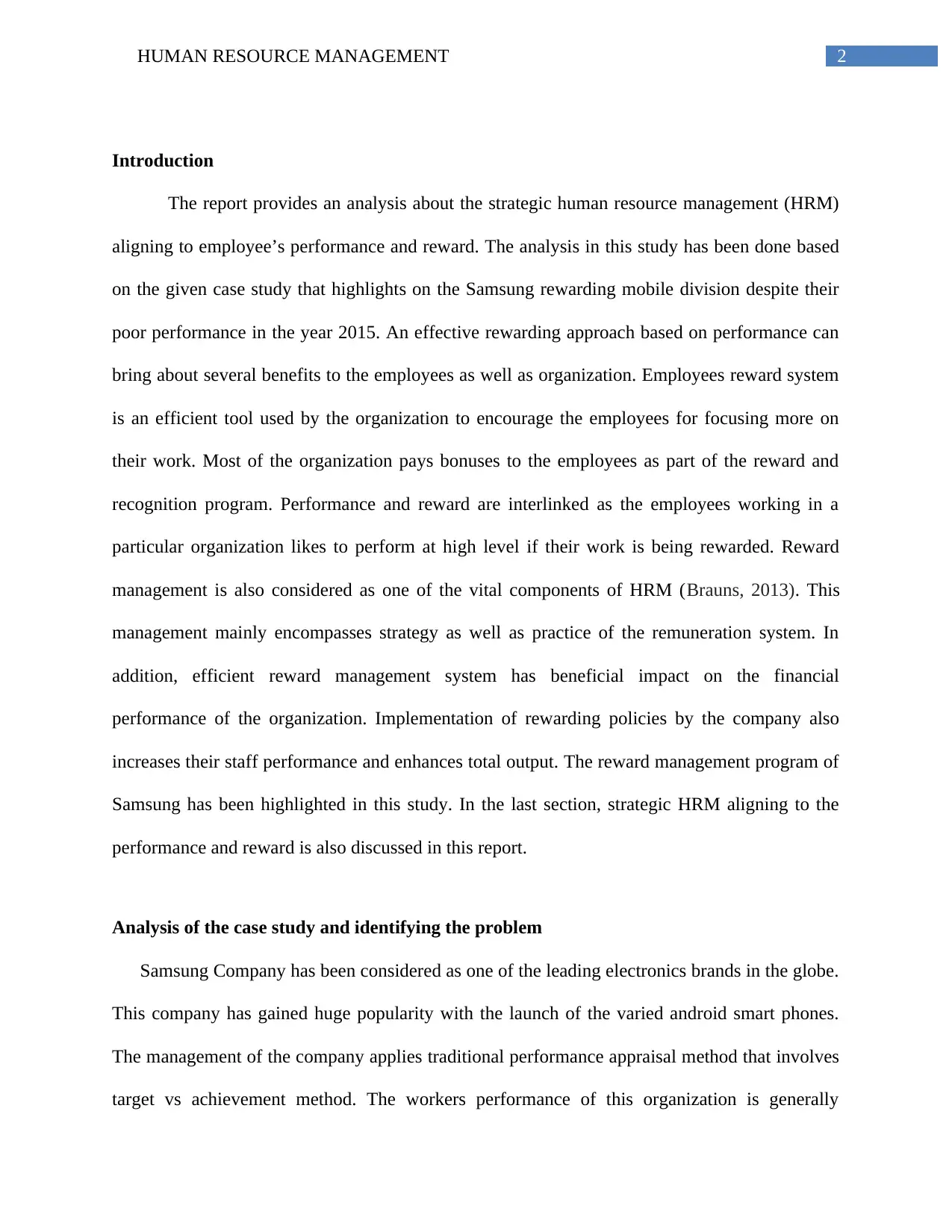
2HUMAN RESOURCE MANAGEMENT
Introduction
The report provides an analysis about the strategic human resource management (HRM)
aligning to employee’s performance and reward. The analysis in this study has been done based
on the given case study that highlights on the Samsung rewarding mobile division despite their
poor performance in the year 2015. An effective rewarding approach based on performance can
bring about several benefits to the employees as well as organization. Employees reward system
is an efficient tool used by the organization to encourage the employees for focusing more on
their work. Most of the organization pays bonuses to the employees as part of the reward and
recognition program. Performance and reward are interlinked as the employees working in a
particular organization likes to perform at high level if their work is being rewarded. Reward
management is also considered as one of the vital components of HRM (Brauns, 2013). This
management mainly encompasses strategy as well as practice of the remuneration system. In
addition, efficient reward management system has beneficial impact on the financial
performance of the organization. Implementation of rewarding policies by the company also
increases their staff performance and enhances total output. The reward management program of
Samsung has been highlighted in this study. In the last section, strategic HRM aligning to the
performance and reward is also discussed in this report.
Analysis of the case study and identifying the problem
Samsung Company has been considered as one of the leading electronics brands in the globe.
This company has gained huge popularity with the launch of the varied android smart phones.
The management of the company applies traditional performance appraisal method that involves
target vs achievement method. The workers performance of this organization is generally
Introduction
The report provides an analysis about the strategic human resource management (HRM)
aligning to employee’s performance and reward. The analysis in this study has been done based
on the given case study that highlights on the Samsung rewarding mobile division despite their
poor performance in the year 2015. An effective rewarding approach based on performance can
bring about several benefits to the employees as well as organization. Employees reward system
is an efficient tool used by the organization to encourage the employees for focusing more on
their work. Most of the organization pays bonuses to the employees as part of the reward and
recognition program. Performance and reward are interlinked as the employees working in a
particular organization likes to perform at high level if their work is being rewarded. Reward
management is also considered as one of the vital components of HRM (Brauns, 2013). This
management mainly encompasses strategy as well as practice of the remuneration system. In
addition, efficient reward management system has beneficial impact on the financial
performance of the organization. Implementation of rewarding policies by the company also
increases their staff performance and enhances total output. The reward management program of
Samsung has been highlighted in this study. In the last section, strategic HRM aligning to the
performance and reward is also discussed in this report.
Analysis of the case study and identifying the problem
Samsung Company has been considered as one of the leading electronics brands in the globe.
This company has gained huge popularity with the launch of the varied android smart phones.
The management of the company applies traditional performance appraisal method that involves
target vs achievement method. The workers performance of this organization is generally
⊘ This is a preview!⊘
Do you want full access?
Subscribe today to unlock all pages.

Trusted by 1+ million students worldwide

3HUMAN RESOURCE MANAGEMENT
evaluated on the basis of their achievement during the particular period. However, this company
rewards their employees based on whether they have the ability to meet the goal. The given case
study reflects that this organization does not have higher payment system, thereby supplements
their workers base salary with yearly bonuses (Jung, 2014). These bonuses are mainly capped at
50% of the salary of the workers and are generally rewarded for exceeding the profit target
specified to each division. In the year 2015, the mobile section of this company had low
performance in respect of sales. Despite performing poorly, the management of Samsung
company paid maximum bonus to their employees for their sincere contribution in keeping this
mobile section running inspite of numerous challenges (Kehoe & Wright, 2013). The employees
of this mobile section were awarded with 50% bonus while the employees of other sections were
given less bonus as compared to this section. The employees of the other division were of the
view that the company did not treat them well because the workers in the mobile division were
paid higher bonus despite performing badly. The main problem that reflects from the above case
study is that there was less cooperation between the managers and the employees while
designing the reward system (Chomal & Baruah 2014). As a result, it did not satisfy the
employees of other sections including consumers electronics , technology centre, digital media
research lab, semiconductor division etc. Historically, this reward system did not function on the
employees side of the organization. It has been suggested by Cho & Perry (2012) that, both
participation as well as cooperation in the payment system design leads to proper understanding
of the company’s operation and hence requires for introduction. Furthermore, the basic factors
that are needed to be considered while designing the reward system includes-
Equity and Comparability- The workers of the company desire to be financially
rewarded in respect of their performance and to be treated fairly. In addition, they also
evaluated on the basis of their achievement during the particular period. However, this company
rewards their employees based on whether they have the ability to meet the goal. The given case
study reflects that this organization does not have higher payment system, thereby supplements
their workers base salary with yearly bonuses (Jung, 2014). These bonuses are mainly capped at
50% of the salary of the workers and are generally rewarded for exceeding the profit target
specified to each division. In the year 2015, the mobile section of this company had low
performance in respect of sales. Despite performing poorly, the management of Samsung
company paid maximum bonus to their employees for their sincere contribution in keeping this
mobile section running inspite of numerous challenges (Kehoe & Wright, 2013). The employees
of this mobile section were awarded with 50% bonus while the employees of other sections were
given less bonus as compared to this section. The employees of the other division were of the
view that the company did not treat them well because the workers in the mobile division were
paid higher bonus despite performing badly. The main problem that reflects from the above case
study is that there was less cooperation between the managers and the employees while
designing the reward system (Chomal & Baruah 2014). As a result, it did not satisfy the
employees of other sections including consumers electronics , technology centre, digital media
research lab, semiconductor division etc. Historically, this reward system did not function on the
employees side of the organization. It has been suggested by Cho & Perry (2012) that, both
participation as well as cooperation in the payment system design leads to proper understanding
of the company’s operation and hence requires for introduction. Furthermore, the basic factors
that are needed to be considered while designing the reward system includes-
Equity and Comparability- The workers of the company desire to be financially
rewarded in respect of their performance and to be treated fairly. In addition, they also
Paraphrase This Document
Need a fresh take? Get an instant paraphrase of this document with our AI Paraphraser
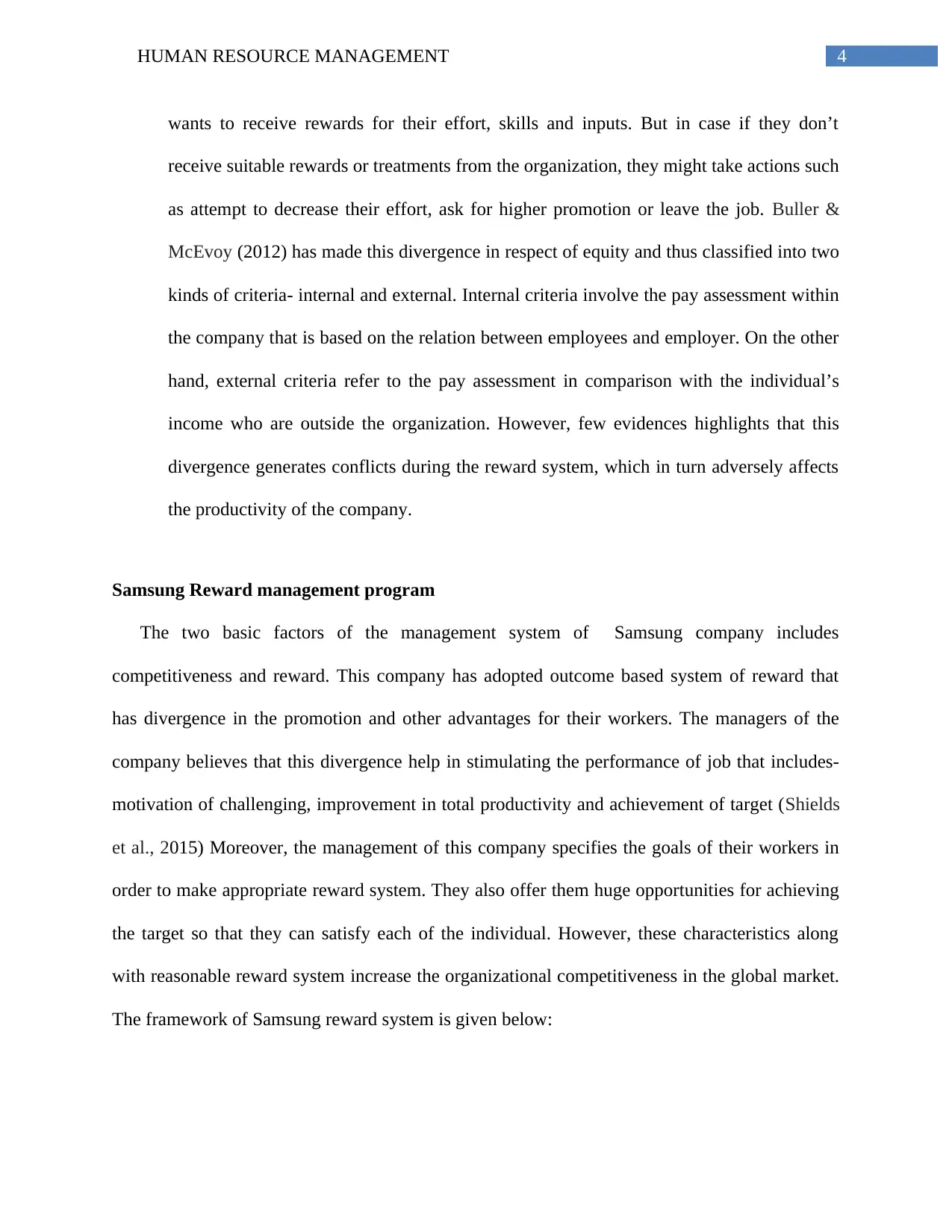
4HUMAN RESOURCE MANAGEMENT
wants to receive rewards for their effort, skills and inputs. But in case if they don’t
receive suitable rewards or treatments from the organization, they might take actions such
as attempt to decrease their effort, ask for higher promotion or leave the job. Buller &
McEvoy (2012) has made this divergence in respect of equity and thus classified into two
kinds of criteria- internal and external. Internal criteria involve the pay assessment within
the company that is based on the relation between employees and employer. On the other
hand, external criteria refer to the pay assessment in comparison with the individual’s
income who are outside the organization. However, few evidences highlights that this
divergence generates conflicts during the reward system, which in turn adversely affects
the productivity of the company.
Samsung Reward management program
The two basic factors of the management system of Samsung company includes
competitiveness and reward. This company has adopted outcome based system of reward that
has divergence in the promotion and other advantages for their workers. The managers of the
company believes that this divergence help in stimulating the performance of job that includes-
motivation of challenging, improvement in total productivity and achievement of target (Shields
et al., 2015) Moreover, the management of this company specifies the goals of their workers in
order to make appropriate reward system. They also offer them huge opportunities for achieving
the target so that they can satisfy each of the individual. However, these characteristics along
with reasonable reward system increase the organizational competitiveness in the global market.
The framework of Samsung reward system is given below:
wants to receive rewards for their effort, skills and inputs. But in case if they don’t
receive suitable rewards or treatments from the organization, they might take actions such
as attempt to decrease their effort, ask for higher promotion or leave the job. Buller &
McEvoy (2012) has made this divergence in respect of equity and thus classified into two
kinds of criteria- internal and external. Internal criteria involve the pay assessment within
the company that is based on the relation between employees and employer. On the other
hand, external criteria refer to the pay assessment in comparison with the individual’s
income who are outside the organization. However, few evidences highlights that this
divergence generates conflicts during the reward system, which in turn adversely affects
the productivity of the company.
Samsung Reward management program
The two basic factors of the management system of Samsung company includes
competitiveness and reward. This company has adopted outcome based system of reward that
has divergence in the promotion and other advantages for their workers. The managers of the
company believes that this divergence help in stimulating the performance of job that includes-
motivation of challenging, improvement in total productivity and achievement of target (Shields
et al., 2015) Moreover, the management of this company specifies the goals of their workers in
order to make appropriate reward system. They also offer them huge opportunities for achieving
the target so that they can satisfy each of the individual. However, these characteristics along
with reasonable reward system increase the organizational competitiveness in the global market.
The framework of Samsung reward system is given below:

5HUMAN RESOURCE MANAGEMENT
The basic yearly salary of the Samsung employees accounts for near about 50 % to 60%
of the total yearly salary
A huge amount of incentives as well as other rewards represents vital part of the person’s
total wage.
The characteristics of reward includes-
Annual Salary- This is mainly decided by the current year assessment outcome regardless
of last year’s salary.
Profit sharing-the company redistributes their excess profits as this is provided when the
employees of the respective departments exceed their target, up to 50% of the total salary.
Productive incentive-This is mainly given when the individuals or the respective
departments attains their targets, near about 300 of the monthly salary.
Non- financial incentive-This includes promotion as well as other beneficial programs.
In the year 2013, this company has launched flexible benefits scheme by utilizing the online
portal for providing their employees higher opportunity to design their benefits package (Lepper
& Greene, 2015). The flexible reward system also includes attaining the feedback of their
employees, constant reviews a well as update of these benefits.
Bonuses affecting employees work performance
Chiang & Birtch (2012) opines that bonuses impact on the work performance of the
employees. The employers along with proper performance management system usually connect
compensation to the ratings of performance appraisal in order to determine bonus for workers.
Furthermore, most of the companies includes bonus as the part of the workers rewards as well as
recognition program. The management of the company usually pay bonuses to the workers who
The basic yearly salary of the Samsung employees accounts for near about 50 % to 60%
of the total yearly salary
A huge amount of incentives as well as other rewards represents vital part of the person’s
total wage.
The characteristics of reward includes-
Annual Salary- This is mainly decided by the current year assessment outcome regardless
of last year’s salary.
Profit sharing-the company redistributes their excess profits as this is provided when the
employees of the respective departments exceed their target, up to 50% of the total salary.
Productive incentive-This is mainly given when the individuals or the respective
departments attains their targets, near about 300 of the monthly salary.
Non- financial incentive-This includes promotion as well as other beneficial programs.
In the year 2013, this company has launched flexible benefits scheme by utilizing the online
portal for providing their employees higher opportunity to design their benefits package (Lepper
& Greene, 2015). The flexible reward system also includes attaining the feedback of their
employees, constant reviews a well as update of these benefits.
Bonuses affecting employees work performance
Chiang & Birtch (2012) opines that bonuses impact on the work performance of the
employees. The employers along with proper performance management system usually connect
compensation to the ratings of performance appraisal in order to determine bonus for workers.
Furthermore, most of the companies includes bonus as the part of the workers rewards as well as
recognition program. The management of the company usually pay bonuses to the workers who
⊘ This is a preview!⊘
Do you want full access?
Subscribe today to unlock all pages.

Trusted by 1+ million students worldwide
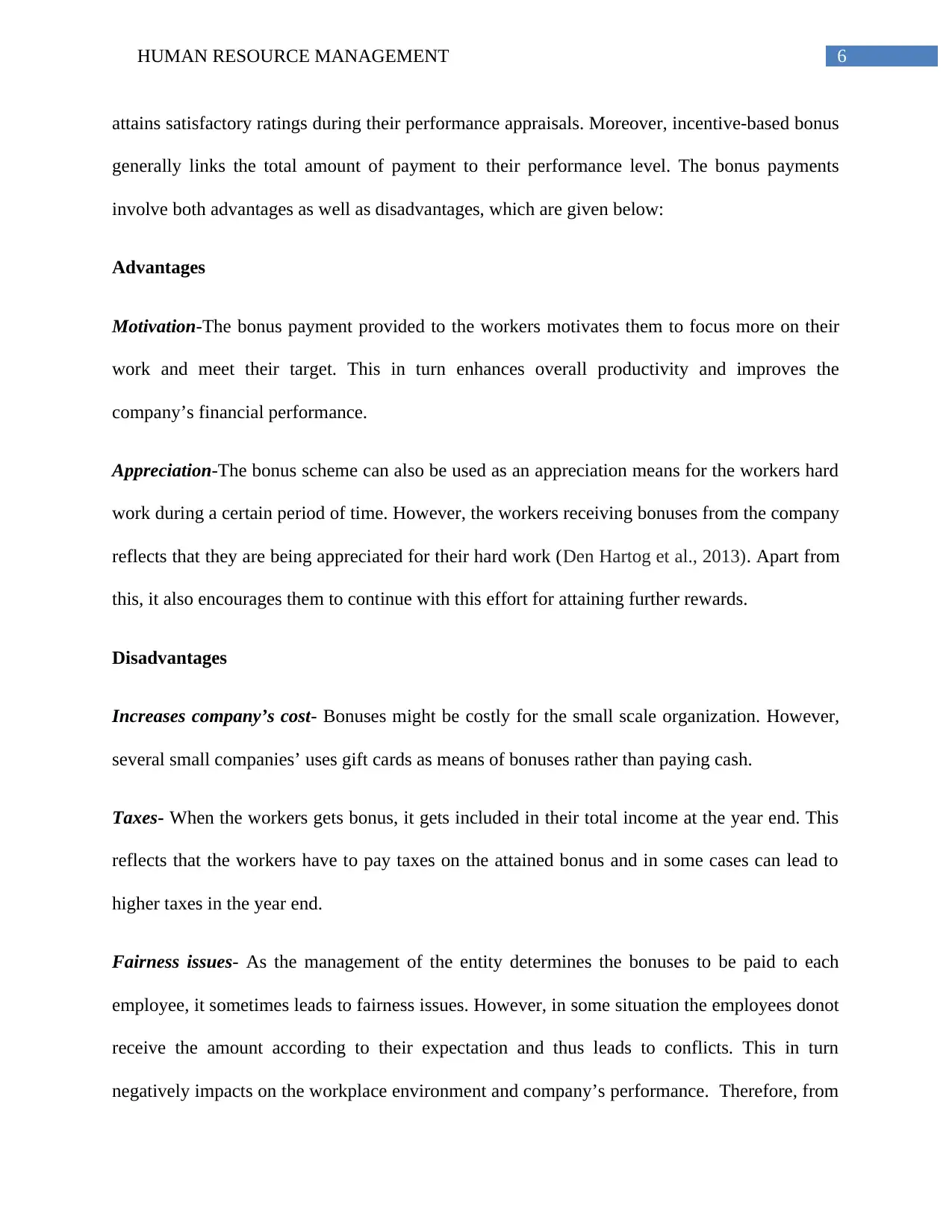
6HUMAN RESOURCE MANAGEMENT
attains satisfactory ratings during their performance appraisals. Moreover, incentive-based bonus
generally links the total amount of payment to their performance level. The bonus payments
involve both advantages as well as disadvantages, which are given below:
Advantages
Motivation-The bonus payment provided to the workers motivates them to focus more on their
work and meet their target. This in turn enhances overall productivity and improves the
company’s financial performance.
Appreciation-The bonus scheme can also be used as an appreciation means for the workers hard
work during a certain period of time. However, the workers receiving bonuses from the company
reflects that they are being appreciated for their hard work (Den Hartog et al., 2013). Apart from
this, it also encourages them to continue with this effort for attaining further rewards.
Disadvantages
Increases company’s cost- Bonuses might be costly for the small scale organization. However,
several small companies’ uses gift cards as means of bonuses rather than paying cash.
Taxes- When the workers gets bonus, it gets included in their total income at the year end. This
reflects that the workers have to pay taxes on the attained bonus and in some cases can lead to
higher taxes in the year end.
Fairness issues- As the management of the entity determines the bonuses to be paid to each
employee, it sometimes leads to fairness issues. However, in some situation the employees donot
receive the amount according to their expectation and thus leads to conflicts. This in turn
negatively impacts on the workplace environment and company’s performance. Therefore, from
attains satisfactory ratings during their performance appraisals. Moreover, incentive-based bonus
generally links the total amount of payment to their performance level. The bonus payments
involve both advantages as well as disadvantages, which are given below:
Advantages
Motivation-The bonus payment provided to the workers motivates them to focus more on their
work and meet their target. This in turn enhances overall productivity and improves the
company’s financial performance.
Appreciation-The bonus scheme can also be used as an appreciation means for the workers hard
work during a certain period of time. However, the workers receiving bonuses from the company
reflects that they are being appreciated for their hard work (Den Hartog et al., 2013). Apart from
this, it also encourages them to continue with this effort for attaining further rewards.
Disadvantages
Increases company’s cost- Bonuses might be costly for the small scale organization. However,
several small companies’ uses gift cards as means of bonuses rather than paying cash.
Taxes- When the workers gets bonus, it gets included in their total income at the year end. This
reflects that the workers have to pay taxes on the attained bonus and in some cases can lead to
higher taxes in the year end.
Fairness issues- As the management of the entity determines the bonuses to be paid to each
employee, it sometimes leads to fairness issues. However, in some situation the employees donot
receive the amount according to their expectation and thus leads to conflicts. This in turn
negatively impacts on the workplace environment and company’s performance. Therefore, from
Paraphrase This Document
Need a fresh take? Get an instant paraphrase of this document with our AI Paraphraser

7HUMAN RESOURCE MANAGEMENT
the above case study, it can be predicted that there can be fairness issue within the Samsung
Company regarding the bonus payment of the workers.
Strategic HRM aligning to performance and Reward
One of the vital strategies that have been used by the human resource (HR) managers is
the reward management. The basic motive behind the implementation of this strategy is to
enhance the performance of their employees through motivation by complying with the
employment regulation as well as legislation. However, the HR managers of the company design
the reward framework that helps the company’s strategic goals as well as individual workers
goals (Daley, 2012). The system of reward is very important for the firms as it helps to retain
employees and also attract skilled individuals. The main purpose of this system of reward is to
provide proper method of delivering positive result. Nevertheless, when the workers surpass their
goal, they should be rewarded in order to encourage them. Being a consultant, it is suggested that
adoption of this strategy by the HRM will help the employees to link the reward with higher
performance that they have achieved. Ferner & Almond (2013) suggested that effective reward
management system should mainly concentrate on positive reinforcement. This in turn will
motivate the behavior of the employees in the company.
One practical example in this context is the reward system offered by the management of
the Kenya Power and Lighting Company (KPLC). This entity transmits and distributes electricity
within the nation and also offers vital services, which supports varied sectors of this nation. The
HRM of this organization has established reward system including cash bonus payment in order
to pursuit of enhancing workers performance for ensuring quality service. Implementation of this
strategy by the KPLC’s management motivated their employees to be highly productive in their
the above case study, it can be predicted that there can be fairness issue within the Samsung
Company regarding the bonus payment of the workers.
Strategic HRM aligning to performance and Reward
One of the vital strategies that have been used by the human resource (HR) managers is
the reward management. The basic motive behind the implementation of this strategy is to
enhance the performance of their employees through motivation by complying with the
employment regulation as well as legislation. However, the HR managers of the company design
the reward framework that helps the company’s strategic goals as well as individual workers
goals (Daley, 2012). The system of reward is very important for the firms as it helps to retain
employees and also attract skilled individuals. The main purpose of this system of reward is to
provide proper method of delivering positive result. Nevertheless, when the workers surpass their
goal, they should be rewarded in order to encourage them. Being a consultant, it is suggested that
adoption of this strategy by the HRM will help the employees to link the reward with higher
performance that they have achieved. Ferner & Almond (2013) suggested that effective reward
management system should mainly concentrate on positive reinforcement. This in turn will
motivate the behavior of the employees in the company.
One practical example in this context is the reward system offered by the management of
the Kenya Power and Lighting Company (KPLC). This entity transmits and distributes electricity
within the nation and also offers vital services, which supports varied sectors of this nation. The
HRM of this organization has established reward system including cash bonus payment in order
to pursuit of enhancing workers performance for ensuring quality service. Implementation of this
strategy by the KPLC’s management motivated their employees to be highly productive in their
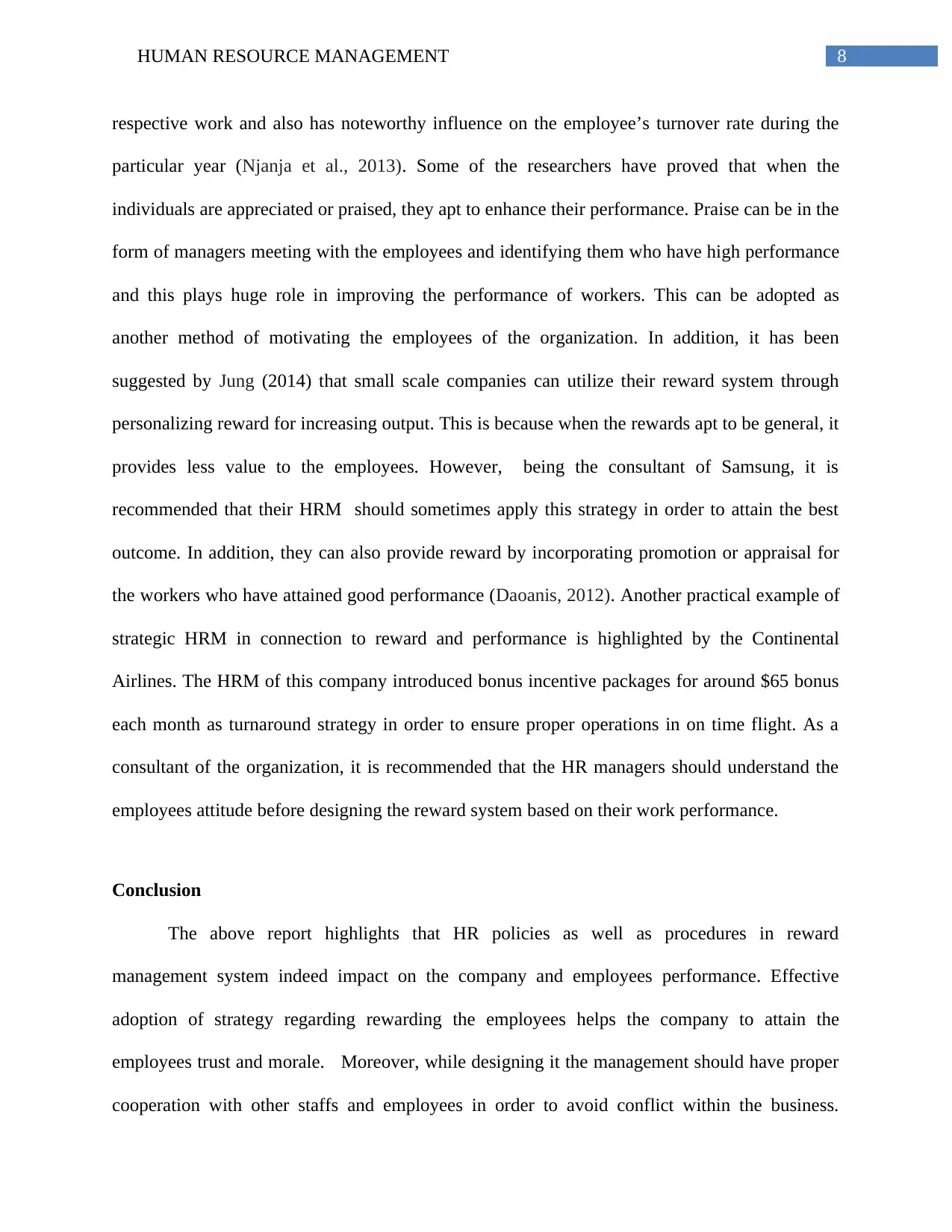
8HUMAN RESOURCE MANAGEMENT
respective work and also has noteworthy influence on the employee’s turnover rate during the
particular year (Njanja et al., 2013). Some of the researchers have proved that when the
individuals are appreciated or praised, they apt to enhance their performance. Praise can be in the
form of managers meeting with the employees and identifying them who have high performance
and this plays huge role in improving the performance of workers. This can be adopted as
another method of motivating the employees of the organization. In addition, it has been
suggested by Jung (2014) that small scale companies can utilize their reward system through
personalizing reward for increasing output. This is because when the rewards apt to be general, it
provides less value to the employees. However, being the consultant of Samsung, it is
recommended that their HRM should sometimes apply this strategy in order to attain the best
outcome. In addition, they can also provide reward by incorporating promotion or appraisal for
the workers who have attained good performance (Daoanis, 2012). Another practical example of
strategic HRM in connection to reward and performance is highlighted by the Continental
Airlines. The HRM of this company introduced bonus incentive packages for around $65 bonus
each month as turnaround strategy in order to ensure proper operations in on time flight. As a
consultant of the organization, it is recommended that the HR managers should understand the
employees attitude before designing the reward system based on their work performance.
Conclusion
The above report highlights that HR policies as well as procedures in reward
management system indeed impact on the company and employees performance. Effective
adoption of strategy regarding rewarding the employees helps the company to attain the
employees trust and morale. Moreover, while designing it the management should have proper
cooperation with other staffs and employees in order to avoid conflict within the business.
respective work and also has noteworthy influence on the employee’s turnover rate during the
particular year (Njanja et al., 2013). Some of the researchers have proved that when the
individuals are appreciated or praised, they apt to enhance their performance. Praise can be in the
form of managers meeting with the employees and identifying them who have high performance
and this plays huge role in improving the performance of workers. This can be adopted as
another method of motivating the employees of the organization. In addition, it has been
suggested by Jung (2014) that small scale companies can utilize their reward system through
personalizing reward for increasing output. This is because when the rewards apt to be general, it
provides less value to the employees. However, being the consultant of Samsung, it is
recommended that their HRM should sometimes apply this strategy in order to attain the best
outcome. In addition, they can also provide reward by incorporating promotion or appraisal for
the workers who have attained good performance (Daoanis, 2012). Another practical example of
strategic HRM in connection to reward and performance is highlighted by the Continental
Airlines. The HRM of this company introduced bonus incentive packages for around $65 bonus
each month as turnaround strategy in order to ensure proper operations in on time flight. As a
consultant of the organization, it is recommended that the HR managers should understand the
employees attitude before designing the reward system based on their work performance.
Conclusion
The above report highlights that HR policies as well as procedures in reward
management system indeed impact on the company and employees performance. Effective
adoption of strategy regarding rewarding the employees helps the company to attain the
employees trust and morale. Moreover, while designing it the management should have proper
cooperation with other staffs and employees in order to avoid conflict within the business.
⊘ This is a preview!⊘
Do you want full access?
Subscribe today to unlock all pages.

Trusted by 1+ million students worldwide

9HUMAN RESOURCE MANAGEMENT
Additionally, variable pay also plays vital role to boost the employees especially star performers
rather than fixed salary package. Therefore, it is necessary for every organization to recruit
skilled HR managers in order to improve the employees and company’s performance in the
longer run.
Additionally, variable pay also plays vital role to boost the employees especially star performers
rather than fixed salary package. Therefore, it is necessary for every organization to recruit
skilled HR managers in order to improve the employees and company’s performance in the
longer run.
Paraphrase This Document
Need a fresh take? Get an instant paraphrase of this document with our AI Paraphraser
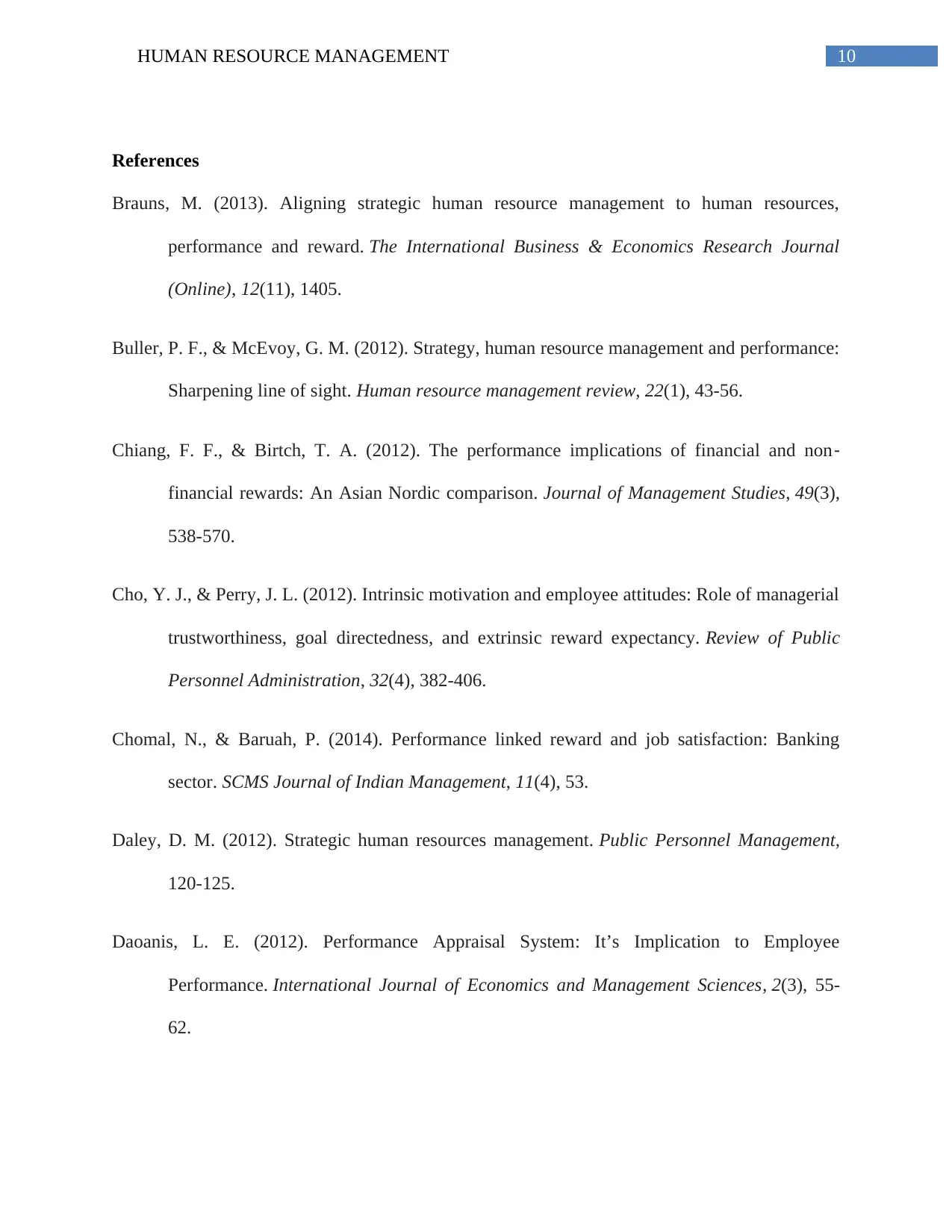
10HUMAN RESOURCE MANAGEMENT
References
Brauns, M. (2013). Aligning strategic human resource management to human resources,
performance and reward. The International Business & Economics Research Journal
(Online), 12(11), 1405.
Buller, P. F., & McEvoy, G. M. (2012). Strategy, human resource management and performance:
Sharpening line of sight. Human resource management review, 22(1), 43-56.
Chiang, F. F., & Birtch, T. A. (2012). The performance implications of financial and non‐
financial rewards: An Asian Nordic comparison. Journal of Management Studies, 49(3),
538-570.
Cho, Y. J., & Perry, J. L. (2012). Intrinsic motivation and employee attitudes: Role of managerial
trustworthiness, goal directedness, and extrinsic reward expectancy. Review of Public
Personnel Administration, 32(4), 382-406.
Chomal, N., & Baruah, P. (2014). Performance linked reward and job satisfaction: Banking
sector. SCMS Journal of Indian Management, 11(4), 53.
Daley, D. M. (2012). Strategic human resources management. Public Personnel Management,
120-125.
Daoanis, L. E. (2012). Performance Appraisal System: It’s Implication to Employee
Performance. International Journal of Economics and Management Sciences, 2(3), 55-
62.
References
Brauns, M. (2013). Aligning strategic human resource management to human resources,
performance and reward. The International Business & Economics Research Journal
(Online), 12(11), 1405.
Buller, P. F., & McEvoy, G. M. (2012). Strategy, human resource management and performance:
Sharpening line of sight. Human resource management review, 22(1), 43-56.
Chiang, F. F., & Birtch, T. A. (2012). The performance implications of financial and non‐
financial rewards: An Asian Nordic comparison. Journal of Management Studies, 49(3),
538-570.
Cho, Y. J., & Perry, J. L. (2012). Intrinsic motivation and employee attitudes: Role of managerial
trustworthiness, goal directedness, and extrinsic reward expectancy. Review of Public
Personnel Administration, 32(4), 382-406.
Chomal, N., & Baruah, P. (2014). Performance linked reward and job satisfaction: Banking
sector. SCMS Journal of Indian Management, 11(4), 53.
Daley, D. M. (2012). Strategic human resources management. Public Personnel Management,
120-125.
Daoanis, L. E. (2012). Performance Appraisal System: It’s Implication to Employee
Performance. International Journal of Economics and Management Sciences, 2(3), 55-
62.
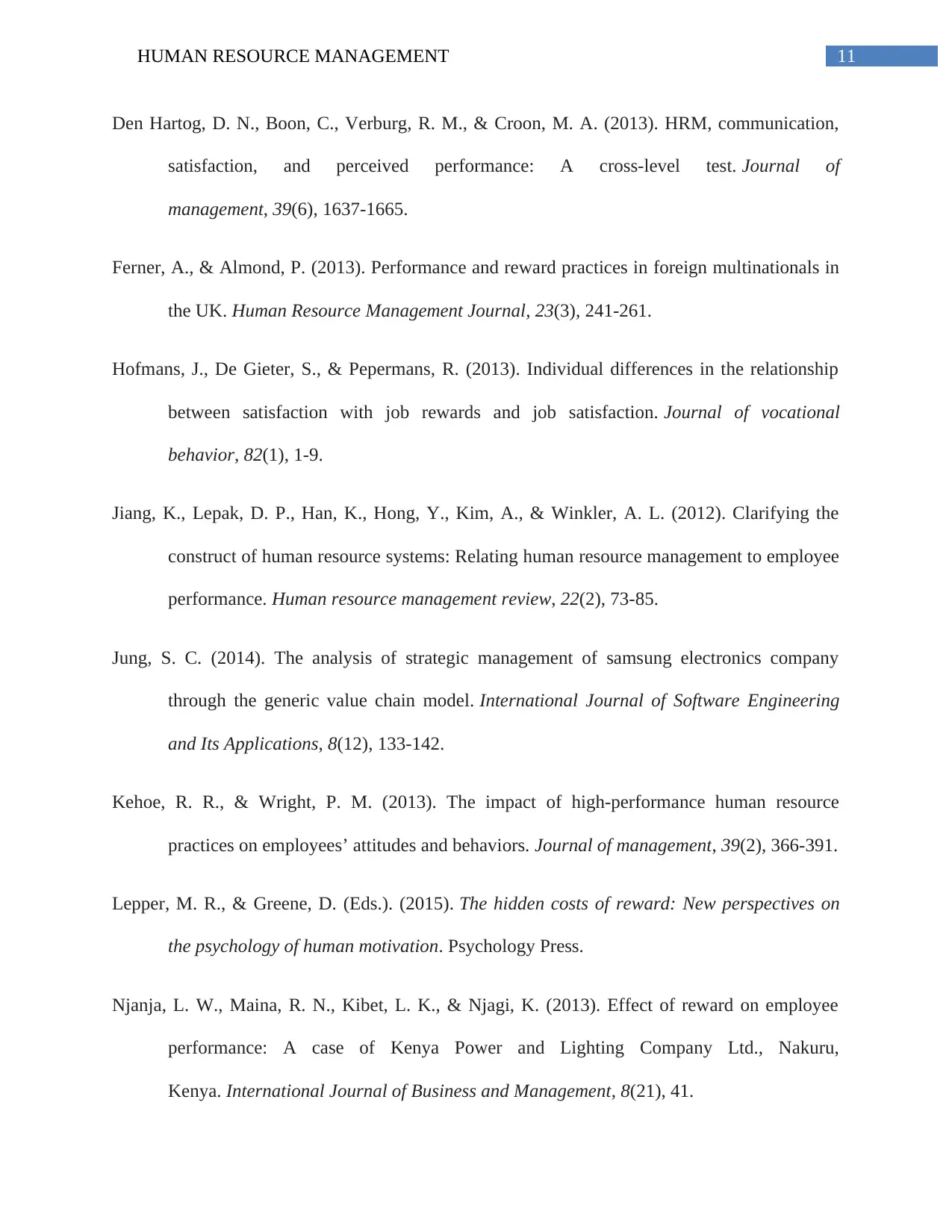
11HUMAN RESOURCE MANAGEMENT
Den Hartog, D. N., Boon, C., Verburg, R. M., & Croon, M. A. (2013). HRM, communication,
satisfaction, and perceived performance: A cross-level test. Journal of
management, 39(6), 1637-1665.
Ferner, A., & Almond, P. (2013). Performance and reward practices in foreign multinationals in
the UK. Human Resource Management Journal, 23(3), 241-261.
Hofmans, J., De Gieter, S., & Pepermans, R. (2013). Individual differences in the relationship
between satisfaction with job rewards and job satisfaction. Journal of vocational
behavior, 82(1), 1-9.
Jiang, K., Lepak, D. P., Han, K., Hong, Y., Kim, A., & Winkler, A. L. (2012). Clarifying the
construct of human resource systems: Relating human resource management to employee
performance. Human resource management review, 22(2), 73-85.
Jung, S. C. (2014). The analysis of strategic management of samsung electronics company
through the generic value chain model. International Journal of Software Engineering
and Its Applications, 8(12), 133-142.
Kehoe, R. R., & Wright, P. M. (2013). The impact of high-performance human resource
practices on employees’ attitudes and behaviors. Journal of management, 39(2), 366-391.
Lepper, M. R., & Greene, D. (Eds.). (2015). The hidden costs of reward: New perspectives on
the psychology of human motivation. Psychology Press.
Njanja, L. W., Maina, R. N., Kibet, L. K., & Njagi, K. (2013). Effect of reward on employee
performance: A case of Kenya Power and Lighting Company Ltd., Nakuru,
Kenya. International Journal of Business and Management, 8(21), 41.
Den Hartog, D. N., Boon, C., Verburg, R. M., & Croon, M. A. (2013). HRM, communication,
satisfaction, and perceived performance: A cross-level test. Journal of
management, 39(6), 1637-1665.
Ferner, A., & Almond, P. (2013). Performance and reward practices in foreign multinationals in
the UK. Human Resource Management Journal, 23(3), 241-261.
Hofmans, J., De Gieter, S., & Pepermans, R. (2013). Individual differences in the relationship
between satisfaction with job rewards and job satisfaction. Journal of vocational
behavior, 82(1), 1-9.
Jiang, K., Lepak, D. P., Han, K., Hong, Y., Kim, A., & Winkler, A. L. (2012). Clarifying the
construct of human resource systems: Relating human resource management to employee
performance. Human resource management review, 22(2), 73-85.
Jung, S. C. (2014). The analysis of strategic management of samsung electronics company
through the generic value chain model. International Journal of Software Engineering
and Its Applications, 8(12), 133-142.
Kehoe, R. R., & Wright, P. M. (2013). The impact of high-performance human resource
practices on employees’ attitudes and behaviors. Journal of management, 39(2), 366-391.
Lepper, M. R., & Greene, D. (Eds.). (2015). The hidden costs of reward: New perspectives on
the psychology of human motivation. Psychology Press.
Njanja, L. W., Maina, R. N., Kibet, L. K., & Njagi, K. (2013). Effect of reward on employee
performance: A case of Kenya Power and Lighting Company Ltd., Nakuru,
Kenya. International Journal of Business and Management, 8(21), 41.
⊘ This is a preview!⊘
Do you want full access?
Subscribe today to unlock all pages.

Trusted by 1+ million students worldwide
1 out of 13
Related Documents
Your All-in-One AI-Powered Toolkit for Academic Success.
+13062052269
info@desklib.com
Available 24*7 on WhatsApp / Email
![[object Object]](/_next/static/media/star-bottom.7253800d.svg)
Unlock your academic potential
Copyright © 2020–2025 A2Z Services. All Rights Reserved. Developed and managed by ZUCOL.





